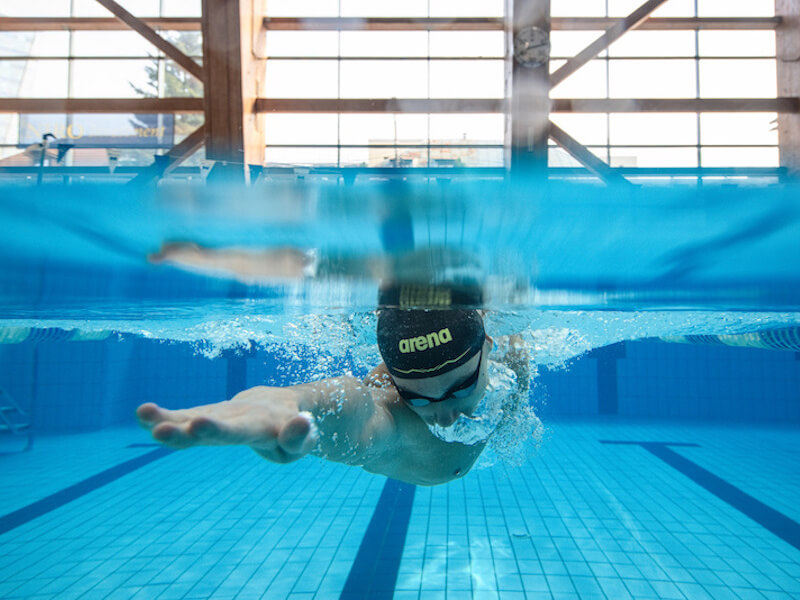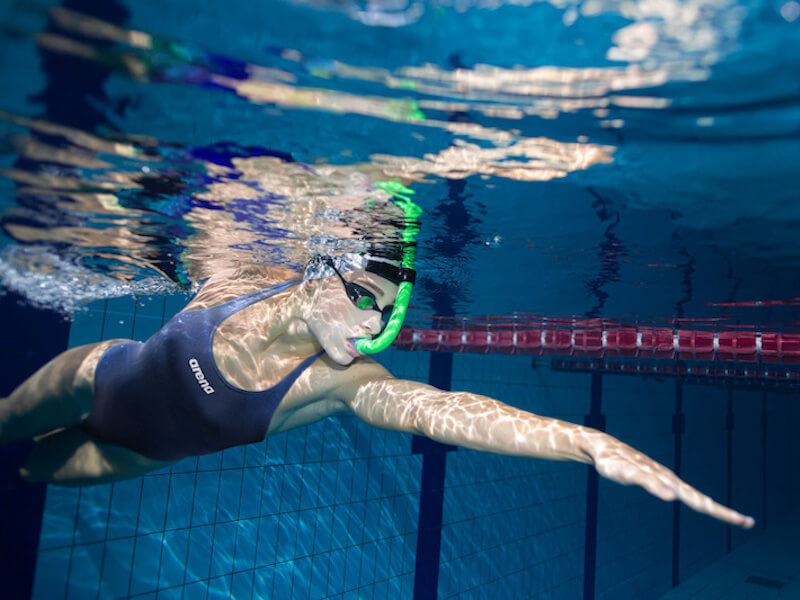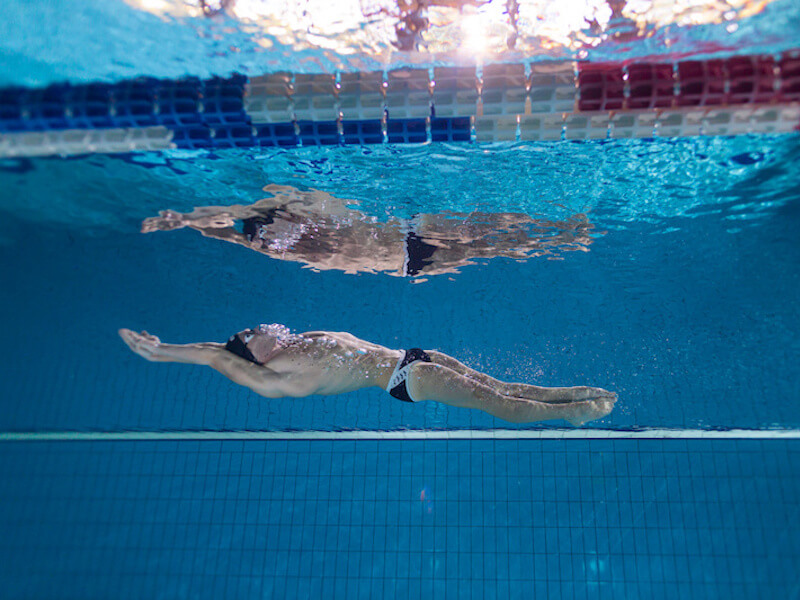Learn How to Increase Lung Capacity for Swimming
The stand out feature of swimming that makes it different from many other physical activities is the fact that it takes place in water. This forces you to get tactical about your breathing as you swim. Three out of four of the Olympic strokes require you to swim with your face often submerged in the water. Learning how to increase lung capacity for swimming is essential if you want to enjoy the benefits that better breathing can bring to your stroke.
In this article, we’ll analyze Olympic swimmers to give us some insight into what good breath control looks like. Then, we’ll have a look at the advantages that come from greater lung volume. Lastly, we’ll find out how to increase lung capacity for swimming by using specific swimming workouts.
Lung Capacity Case Study

Before we take a deep dive into how to increase lung capacity for swimming, let’s do a little simple research. Find any video online of one of the 50-meter freestyle finals at the Olympics.
As well as the startling speeds at which they swim, you might also notice that on average each swimmer takes 1-2 breaths at most, and there are even some swimmers who do not breathe at all for the entire 50 meters. This shows how important having excellent lung capacity is for a swimmer. Of course, we are not suggesting you should only breathe once or twice at most every 50 meters, but there is something to be learned from this breath-holding.
In a nutshell, our lung capacity tells us how well our lungs work. This can be measured (usually as part of a medical sports check-up) with a spirometry test. Regular exercise improves your lung capacity over time. Smoking does the opposite, reducing your lung capacity.
But do not be fooled into thinking that having a good lung capacity simply means being able to hold your breath longer. Otherwise, it would only apply to freestyle and butterfly swimmers, and it would be of no use to backstrokers (seeing as they can breathe all the time) or breaststrokers (who breathe every stroke). Learning how to increase lung capacity for swimming gives more advantages than you may think.
The Advantages of Increasing Your Lung Capacity
Improving your lung health can do wonders for your competitive swimming results. Let’s take a look at the advantages of increasing your lung capacity.
Improved Lung Function
We have already mentioned that good lung capacity means better lung function. Oxygen and glucose are the basis of all the chemical reactions taking place in our body to create the energy that allows us to move (and live). Training this capacity means having more oxygen available and, hence, improving your anaerobic energy function.
This means that increased lung capacity improves your cardiovascular abilities across all strokes. More efficient breathing patterns will keep your muscles full of oxygenated blood for better overall swimming performance.
Better Buoyancy
It is also worth noting that the oxygen in your lungs helps you float. Being able to float better naturally, before even moving a muscle, is a massive confidence booster and is a common goal among most swimmers.
Competitive swimmers know that training with an increased lung capacity will improve their body position in the water. A slightly higher floating position means less drag in the water and improved hydrodynamics.
Increased Oxygen to the Brain
As we mentioned earlier, increased lung capacity means there is more oxygen flowing around the body. The obvious outcome that a swimmer would be focused on from this is improved oxygenation of muscles.
However, this provides more oxygen to the brain as well, which can actually help to improve concentration and focus. This is a huge advantage for swimmers, as a wandering mind during relentless cardio can lead to sloppy strokes and poorer times. Improved focus thanks to more oxygen can help you to stay cognizant of your stroke from start to finish during your races.
How to Increase Lung Capacity for Swimming With Specialized Workouts

Now that you’re aware of the advantages, let’s find out how to increase lung capacity for swimming. Thankfully, these exercises and breathing techniques require very little to no equipment, and as long as you’re fit and injury free, they’re simple to follow. You can start right now.
Controlled Breathing
This exercise is so easy that you can warm up your respiratory muscles without even getting in the pool. You can perform this exercise at home, and it is an excellent way of relaxing too.
Slowly breathe in as deeply as you can, and hold your breath for five seconds. Then, breathe out as much as possible, and wait five seconds before repeating the exercise. Take 10 deep breaths in and out.
Breathing in Time with Your Arm Stroke
Let’s go back to the pool for this exercise. Swimming freestyle, alternate your breathing every 2/3/4/5/6/7/8/9 strokes. This exercise works well during strenuous swim training or just during your warm-up phase.
Breathing a Set Number of Times over a Certain Distance
This exercise is a form of hypoxic training, which forces your body to perform with more carbon dioxide and less oxygen.
Set a maximum number of breaths for each lap of the pool. Begin by swimming freestyle 300/400 meters and then gradually increase the intensity.
Pursed Lip Breathing
Here’s another breathing exercise you can enjoy at home, even while watching your favorite TV show or doing chores. This exercise will help you to slow down your breathing and gain better breath control.
Simply inhale slowly through your nose, and then, exhale as slowly as you can through pursed lips. The exhale should take at least twice as long as the inhale did. This exercise can be repeated as many times as you desire. Try to think of pursed lip breathing more as a daily habit than a breathing exercise.
Swim Snorkel Training
Swim any face-down stroke you like in any fashion, but make sure you wear a swim snorkel during your lengths. For this hypoxic exercise to work, it’s imperative that you use a snorkel that features a limiter to make breathing more difficult (akin to wearing an altitude mask). The Swim Snorkel Pro III from arena is perfect for the job.
Breathe Better Today

Increasing your lung capacity isn’t just a no-brainer for competitive swimming, it’s also a great thing to do generally for your long-term health and wellbeing. Make sure you take our advice and analyze the Olympian swimmers to see for yourself what proper breathing looks like.
Remember that learning how to increase lung capacity for swimming has some serious advantages. Your lung function will improve, you’ll float better, and you can even gain sharper focus in the pool. Try out our exercises and breathing techniques if you want to take the plunge, both in the pool and at home.
If you’re serious about improving your lung capacity to get better results in the pool, you’ll find swim training snorkels and tons of other tools and quality swimwear on arena’s online store.
Written by:
arena coaches
Swim coaches, trainers and experts will give you all kinds of tips for performing at your best in both training and races.







